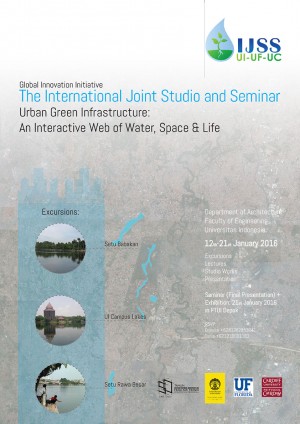
The International Joint Studio and Seminar (IJJS) “Urban Green Infrastructure: An Interactive Web of Water, Space & Life”
21/01/2016
Department of Architecture Universitas Indonesia
The Global Innovation Initiative awarded a grant to the University of Florida, Cardiff University and the Universitas Indonesia with the following research aim: Novel approaches of employing green infrastructure (GI) to enhance urban sustainability. The January 2016 International Joint Studio and Seminar (IJJS) in Jakarta and Depok at the Universitas Indonesia focuses on the issue of urban green infrastructure in three urban locations, namely Setu Babakan, a cultural community on the Setu Srengseng Sawah lake on the southern part of Jakarta near Depok and upstream rivers to UI Campus lakes, namely the southern and eastern inlets that are impacted by traces of trash and settlements. The third urban location (Setu Rawa Besar in Depok) is impacted by commercial activity and development sprawl. This case is related to topics that concern water, waste management and environmental public policy from the Depok City government.
Manuel De Landa in A Thousand Years of Nonlinear History uses geological, biological and linguistic metaphors to describe the development of cities in the last millennium. In a geological sense, the crystallization of cities derives from the materiality of buildings, walls and infrastructure, much like geologic strata. In terms of a biological analogy, the trabecular meshwork around the eye drains the aqueous humor into the anterior chamber and subsequently into the blood stream. The biological meshwork derives its sustenance from the flow of water in relation to the interlocking chains of the food web. Comparatively, alluvial river systems deposit soil along the riverbank and shape the channel morphology of flood plains and terraces. Green infrastructure shapes the flow of water in harmony with nature and human activities. Grey infrastructure forms a mineralized web of reinforced concrete gutters, retaining walls and dams. The interactive web alludes to the linguistic connectivity between atmospheric, geologic and human cycles. The meshwork of human activity in terms of architecture and space strengthens the linkages between the natural and manmade environments. Life itself encompasses the dynamic cultural attitudes towards the wellspring of human activity and the reality of public policy to determine management of water and sustainable urban green infrastructure development. This Interactive web explores four sub-topic that related to:
- Socio/Economic and Cultural Aspects of Water
- Habitats, Places and Resources
- Risk Management through Green Technologies and Public Policy
- Green Infrastructure Modeling
The aim of this Joint Studio and Seminar reflect three outputs. First, the sequence covers field research for identification of water, space and life issues in relation to urban green infrastructure in an interactive web of activities. Second, the joint design studio allows for cross-disciplinary interventions and key proposals for design guidelines to enhance architecture and green infrastructure objectives. Third, the colloquim offers a workshop for dialogue, presentation of ideas and conclusions to further engage in-depth research to enhance urban sustainability and context-sensitive strategies. Students and educators from the University of Florida, Cardiff University and University of Indonesia, as well as community representatives and government officials will participate in the joint design studio and seminar.
JOINT STUDIO AND SEMINAR PHASES
The IJSS will be held from 12 – 21 January 2016. The research and design process
involves three phases:
1. Site Visits & Orientation
- Orientation: Kota Tua Jakarta: Water Issues
- Field Survey, Site Survey, Internet and Literature Research
- Define Issues and Analysis
2. Studio Works and Lectures
- Flow and Network Diagrams and Design Guidelines Strategy
- Development Design Guidelines for Design Intervention
- Series of Lectures from different expertises that related to the topic.
3. Seminar and Exhibition
- Refinement & Publication & Exhibit
The joint studio and seminar concentrates on project definition, field surveys, problem identification, design research and proposed design interventions to facilitate green infrastructure. The process is dependent on individual participation, group work and discourse between the respective disciplines within a critical framework. The experience allows for development of decision making and leadership abilities to address complex urban and environmental issues and to examine the trade-offs involved. Each research topic group is expected to reach the same level of communications ability.
PARTICIPANTS
The participants of the International Joint Studio and Seminar (IJSS) included students from University of Florida, Cardiff University and Universitas Indonesia with various backgrounds as Architecture, Landscape, Urban Planning, Political Science and Journalism.
The group of students will be supervised by fascilitators and lecturers from three participating universities.
The IJSS also invites some experts as resource persons from different backgrounds included Academicians and Researches (from three participating universities); Depok local government, Badan Informasi Geospasial (Kementerian ATR), and representatives from Setu Babakan.
INVITATION
We would like to invite public to attend Seminar (Final Presentation) and Exhibition that will be held on 21 January 2016 at FTUI Depok. For further information and RSVP please contact: Diandra (081282853941) and Tania (081218001182).






